We slipped our lines, and Rex expertly extracted us from between two boats. With the breeze forcing us against the pontoon, this was an impressive achievement.
An idiot at the entrance to the marina dawdled about at starfish pace. He knew we were coming out behind him, but snail man just ignored us and imperceptibly edged along. Rex turned red, stared daggers at the tortoise and emitted a cloud of brown steam.
The 90-minute trip down to Zierikzee was most pleasant, with the sun flooding through gaps in the clouds. A sprinkling of yachts ploughed their furrows over the wide expanse of the Oosterschelde. Rex slowly regained his composure; my knowledge of swear words had been considerably expanded by his utterances in his brief encounter with super swift sailor.
In due course, we reached the entrance to the Havenkanaal that led to the town of Zierikzee. Meryl, by chance, rang Rex at the very moment we entered the canal, with one boat in front of us and another coming out. He was getting flustered ........ .
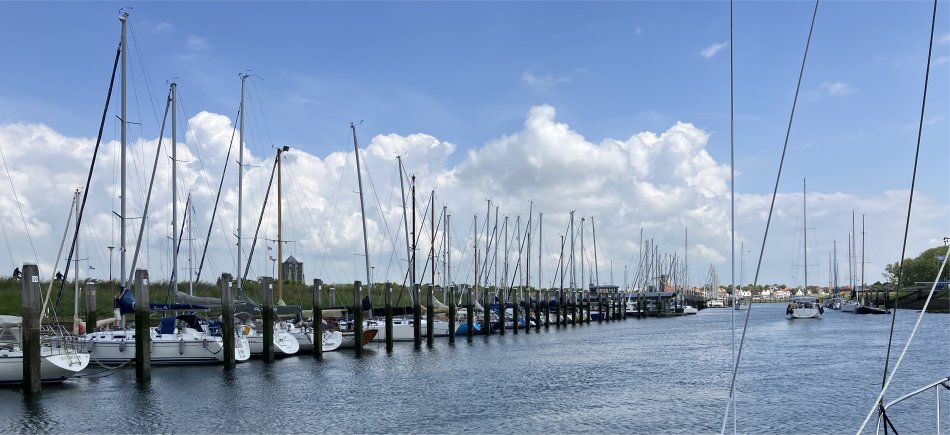 Heading Up the Havenkanaal |
Out popped a cheery young girl, the harbour master. I asked in my best Dutch if we could have a berth. She replied in her best Dutch, "What is the size of your boat?"
Armed with the information, she informed us, fortunately in English, "You can berth on the third long thing along the line of boxes," she said pointing down the ranks of boxes further up the canal. I explained that the 'long thing' was called a hammer head. She laughed, and pointed it out again and left us to it. We headed down to the third hammer head, spun the boat around so that she'd be facing into the wind, and moored.
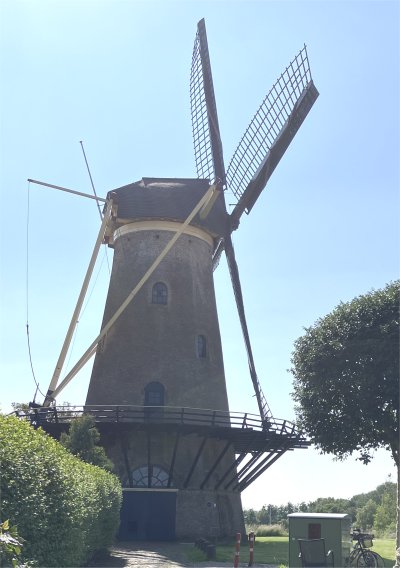 Korenmolen Den Haas |
"I enjoy being moored next to the hammer head," he said, appearing to be pleased he had somebody to talk to. "It enables me to chat to a variety of people who come to visit the town. I bought this boat in Christchurch in England 45 years ago. It's a good boat. I added the covering over the wheelhouse myself. My wife and I have three daughters, and we used to take them sailing during the holidays: the Schelde, Ijmuiden, Ijsselmeer and Markemeer. Being locked into just two weeks holiday, we just went whatever the weather. We once tried to cross the North Sea to England, but the sea was very rough and we decided to turn back. I had to wait for 20 minutes before I found the perfect gap in the waves to turn around. Nowadays, my daughters don't sail anymore. I'm 85 and my wife is 78, and we are not as agile as we used to be. Where have you come from?" he asked.
"We came across from the Roompot," I answered, and related the saga of the bridge mishap at Middelburg. I laughed and told him we had brought the sunshine with us.
"It is only this week the sun has arrived," he informed us. "The weather has been dreadful here. We think the weather is important for sailors. My father was a farmer, and was always watching the weather. There have been times when the ground was so wet he could not get his machines onto the fields."
"That's a nice boat you've got," piped up Rex, attempting to change the subject.
"We're here for the whole of June, " I added.
"Then you will miss the mosquitos," replied the veteran. "We get them most years, and from how the weather conditions have been lately, they are predicted to arrive in July. However, for some unknown reason they don't normally affect Zierikzee."
I went off to pay the harbour master for two nights, chinwagged with Rex over sumptuous tea and teacakes, and watched a long series of boats come up the canal, four of them British; almost like the Henley regatta.
On the way to town in the evening we passed a large motor cruiser from Dublin. Its owners were sitting high up with the gods at the back.
"You've come a long way," I called up to them.
"We have indeed," boomed the chap in response. "Where are you heading?" he asked.
We outlined our itinary, and also learned that they were here for two months with no set agenda, but they knew the Dutch waterways well.
"We used to think the thing to do was to head to the south of France, but when we discovered the Dutch waterways, we absolutely adored them, and we keep returning. Who wouldn't, there is everything here that you want."
We informed them about the broken bridge, which was just as well since they had not been aware of it. Wishing them good luck and fair winds we headed into town.
We strolled down the West Havendijk, admiring some of the craft in the boxes below us. At the town end of the West Havendijk we passed along the Blaue Bolwerk, (Blue Bulwark), the remainder of the fortification of a historic wall from 1621 that had to protect Zierikzee against attacks by the Spanish from the water. The Bolwerk is a wide masonry wall of about seven meters height and sixty meters length. The outer wall consists of bluestone. The passage to the Westhavendijk dated from 1817.
Just behind the Blaue Bolwerk stood the Korenmolen Den Haas, a flour mill dating from 1727. It is a round stone mill with three pairs of grinding stones and a radius of 23.80 meters.
Around 1600, a post mill was built on the Bolwerk, which was demolished in 1723. In 1726, the owners of the De Flesse post mill also requested permission for demolition. This was to build a new mill on site, the Den Haas flour mill.
Grinding was carried out regularly until 1953, after which the mill fell into disrepair. In 1984, the municipality of Schouwen-Duiveland became the owner of the mill and it was restored. The mill was put back into use in 1987. The mill runs almost every Friday and can be visited then.
We were now within the town boundary. Zierikzee is a small town, located on the former island of Schouwen in the province of Zeeland. The conurbation was granted town rights in 1248 and was an independent municipality until 1997. Since the early Middle Ages, Zierikzee was a rich trading town. Its wealth led to the construction of a beautiful port, town hall, mills, church and town walls and gates. One of the many joys of Zierikzee is that itís small and compact with architectural treasures from several different historic periods. Thereís a variety of architectural styles and the historic centre looks like itís been preserved in amber. The town was damaged by the catastrophic North Sea flood of 1953, and received help from the English town of Hatfield. Since then, a friendship has developed between them, and now the two towns are twinned.
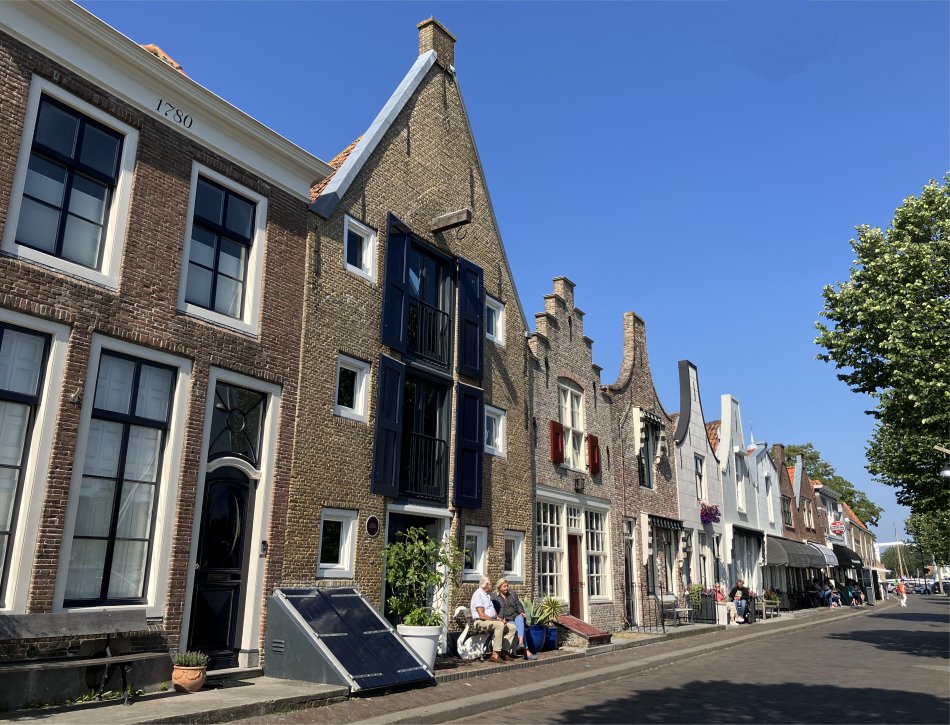 Buildings Along Niuewe Haven |
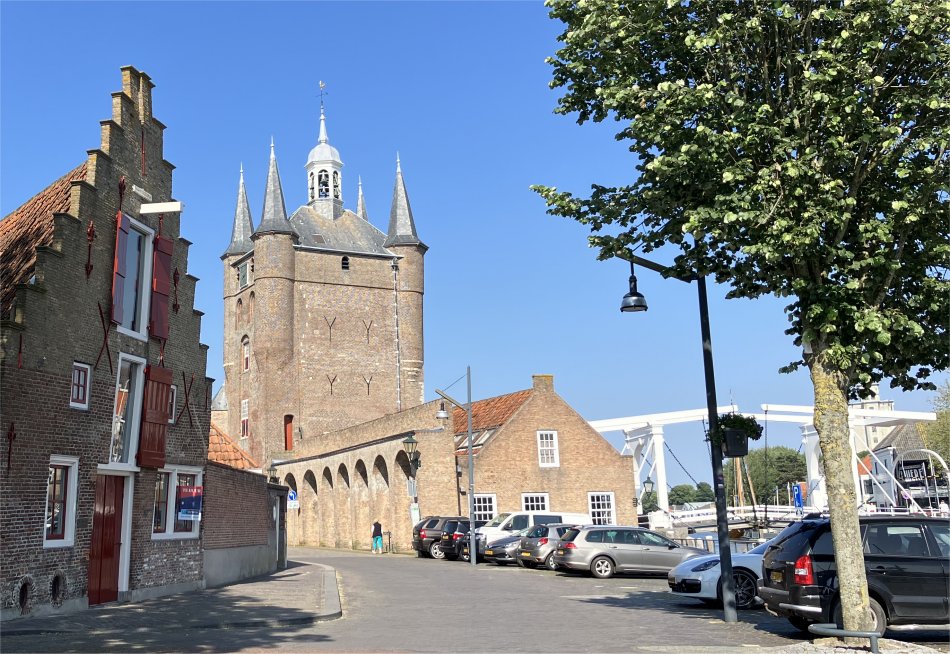 Approaching Zuidhavenpoort Along Niuewe Haven |
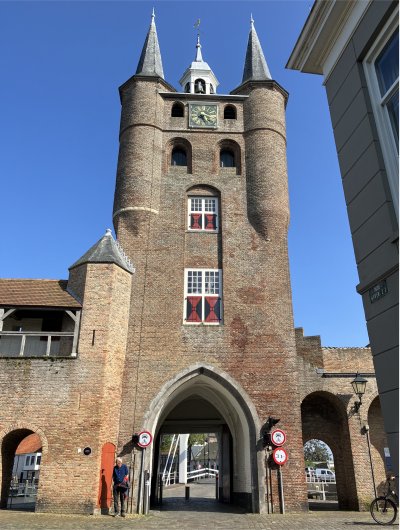 Zuidhavenpoort |
There is a statue of Ad Braat at the Zuidhavenpoort. It is a mother, with her child hidden behind her. Below it the sober text: "Tried, but not broken." It is a reminder of the flood disaster of 1953. Schouwen-Duiveland was the hardest hit island: 531 people lost their lives. The sadness and emotions find their translation in this image. There has been a double drawbridge in front of the Zuidhavenpoort since 1980. Its predecessor was an iron folding bridge that was built in 1927. The municipal council did not hesitate to dig heavily into its own pockets to realize this bridge, which completely matches the gate.
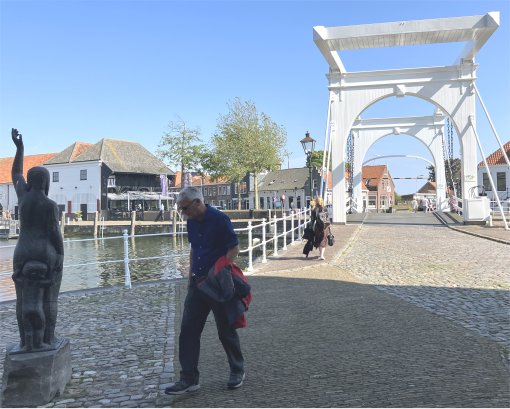 Rex Studying the Statue of Ad Braat |
Continuing our journey, we turned into Oude Haven, also known as the Museumhaven (museum harbour) in Zierikzee. It is owned by the Museumhaven Zeeland foundation which supports the purchase, restoration and conservation of old sailing and motor boats. The foundation has been around since 1990. There were a few traditional Zeeland flat-bottomed boats and historic ships on display.
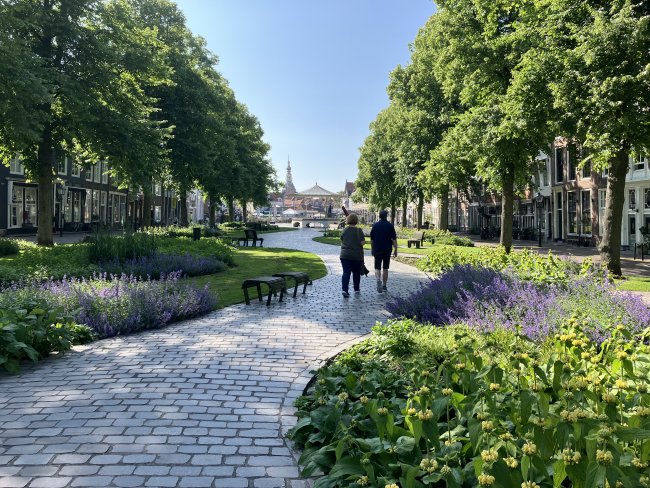 Havenpark |
The Gasthuis or small church was originally the chapel of the guest house, which was founded in the second half of the 14th century and served as a shelter for poor strangers in transit and for the needy sick. Later, insane people were also admitted. The guesthouse was located behind the current church, on Hoge Molenstraat. The chapel was served by its own pastor. The church, like the guest house, was dedicated to the Virgin Mary. After the Reformation, this chapel and church building, like the other properties, were confiscated by the government and given to use by the Walloon Reformed community, which emerged in 1587 and was served by one, later by two, ministers. In 1613, the Walloon congregation, where sermons were preached in French, was allocated a building on Poststraat (until recently part of the Zeeland Music School).
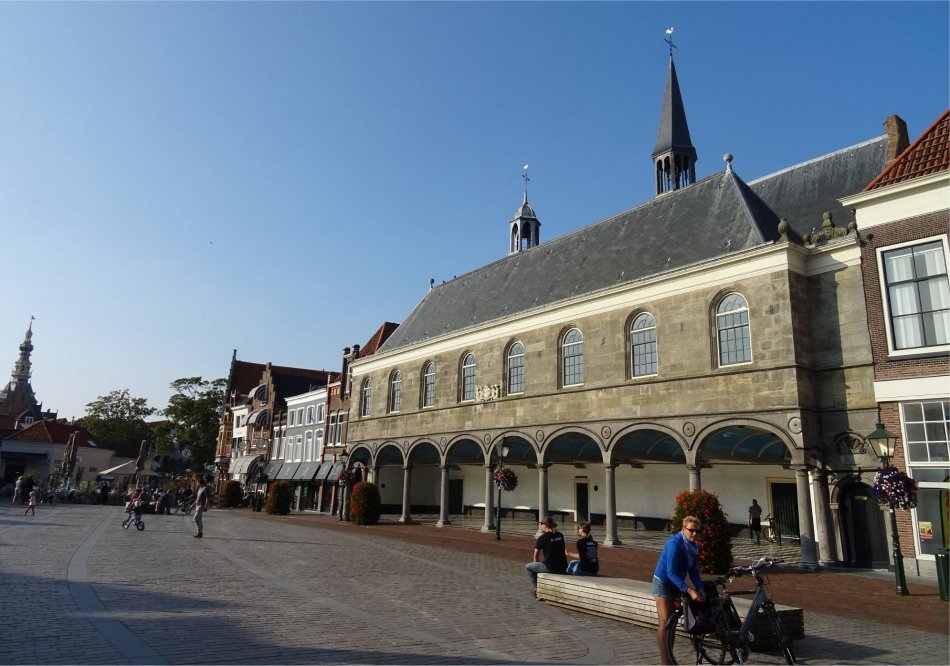 Gasthuiskerk |
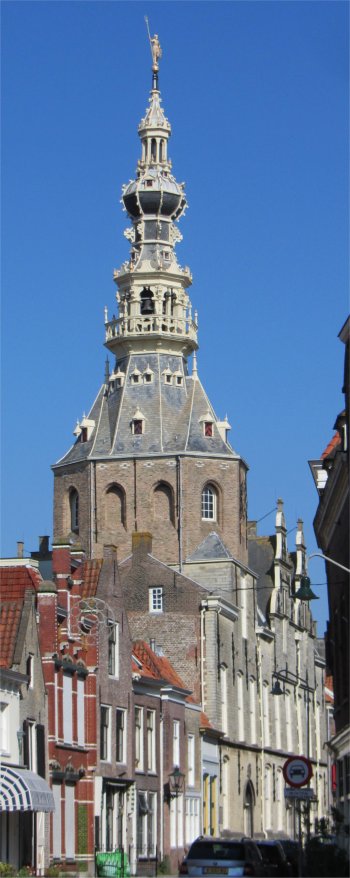 Stadhuismuseum |
The guest house was on the north side and private homes were on the south side. The town council decided to purchase these houses in order to find the necessary space for expansion. It took several more years before all the houses were owned by the town. In 1650, the municipal council ordered the preparation of specifications for the expansion. It was decided to build a stock exchange with a gallery above it. The church therefore received a significant increase in the number of seats. The fair provided the opportunity to trade in an area protected from rain and snow. Close to the harbour and opposite the 'Breede bridge', which served as a place for all kinds of activities, it was an excellent location for traders. In addition, the church became easier to reach. The demolition of the houses took place in 1651. A plan drawn up by the carpenters, Pieter and Bastiaan Vogelaar, was approved and the first stone was laid on Friday, June 3, 1651 (this date can be found on the facade). The gate to the east of the Gasthuiskerk, which formed the entrance to the Gasthuis, was built during this expansion of the Gasthuiskerk in 1651/1652.
In few places in the Netherlands do church and society meet as emphatically as in Zierikzee at the Havenplein. During hot summer days it is wonderfully cool in the fair. There you can enjoy everything that passes by. The Beurs - the Zierikzee residents call it the Beuze - is still a meeting place for many. A nice chat, a lovely walk in the sun, it's all possible here.
We stopped for a beer in the Havenplein before heading up past the Stadhuismuseum (Town Hall Museum) and discovered by chance the Plein Montmaertre, on the corner of Maarstraat and Beddeweeg; in the summer months one of the most vibrant places in the town.
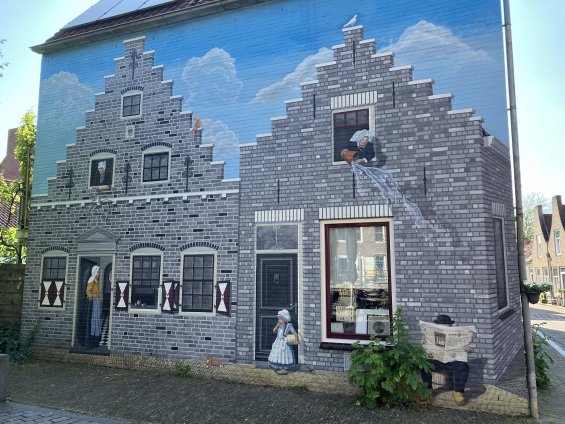 Mural in Plein Montmaertre |
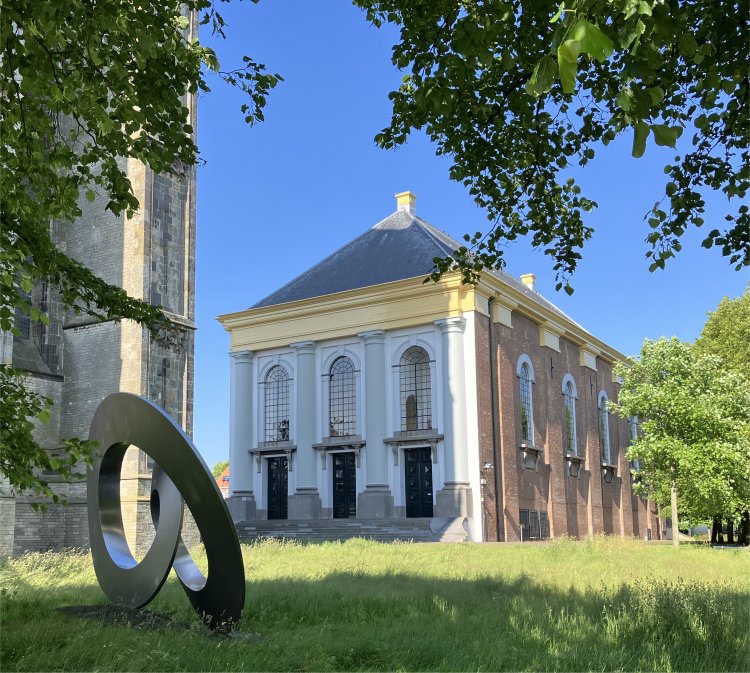 Nieuwe Kerk |
In 2014, the artists from the adjacent Beddeweeg created a mural on a blind side wall, after which it became a new attraction. It is now one of the most photographed places in the town. The initiative to organize Montmaertre was started in 2015. Every Saturday in July and August and a few more times in the spring and autumn, the square is transformed into an art exhibition. Artists work on the square with paint, pencil, clay, fabric, wood and metal. The art quarter was born!
Our final visiting points for today were down on Kerkhof, the first of which was the Nieuwe Kerk. Previously, there was a large cathedral on the same site, Unfortunately, the cathedral burned down in 1832.
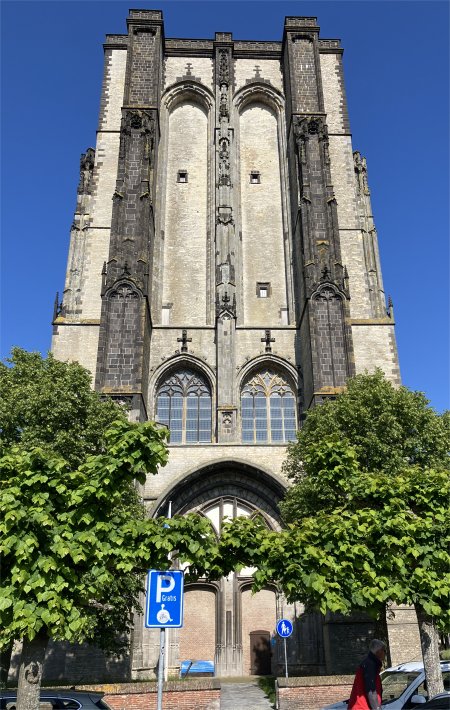 Sint-Lievensmonstertoren |
The Reformed Church, owner of the church, could no longer maintain the Nieuwe Kerk due to the heavy financial burden. The building was closed in 1971, and deteriorated noticeably after windows were smashed and wind and rain were given free rein. A solution came in 1977. The building was transferred to the Old Zeeland Churches Foundation. With financial support, the building was restored in phases in the years 1978-1988. As a beautiful example of 19th century ecclesiastical architecture, the Nieuwe Kerk is a special object in a monumental town such as Zierikzee. The building was festively opened on April 16, 1988.
A short distance past the Nieuwe Kerk stood the striking tall tower that dominates the town silhouette of Zierikzee. and can be seen miles away, the Sint-Lievensmonstertoren (Sint-Lievens Monster Tower), also known as the Dikke Toren (Fat Tower). The construction of the tower began in 1454, and then being by the open sea, it was intended to build the highest tower in the Netherlands, according to some sources 130m tall. During the early phases of its construction the money run out, and it was after a few years before they managed to build a top. It is now 62m tall, unfinished, and a free-standing church tower, the accompanying church being destroyed by a fire in 1832. The tower is built with several million bricks. Unfortunately the tower was closed today.
In the evening, we dined at the Restaurant de Beuze in the Havenplein. I noticed two oddly dressed characters approaching along the Mol. They were attired in what appeared to be long dungarees with large red braces. They kept peering at the ground conversing and pointing, and then wandered off. Ten minutes later a fire-engine turned up and stopped 20m down the Mol from where we sitting. Immediately young firemen poured out of the engine and flung open the back of it, and dragged out traffic cones which were carried at a sprint to strategic locations on the road. Fire hoses were then rolled out to within 4m of where we sat, and a water main opened up. A jet of water shot out, soaking a cyclist, who had obviously paid no heed to the traffic cones. The hose was soon connected to the main, and was quickly bulging with water under pressure. All the while this process was being carried out, one of the characters I had spotted earlier was carefully scrutinising their actions. We realised this was a fire drill.
All good things must come to an end, and the engine and crew cleared off. Half an hour later, the fire-engine returned with a different crew, and the whole exercise was repeated, with pedestrians, cyclists and scooters wading through it all totally oblivious.
